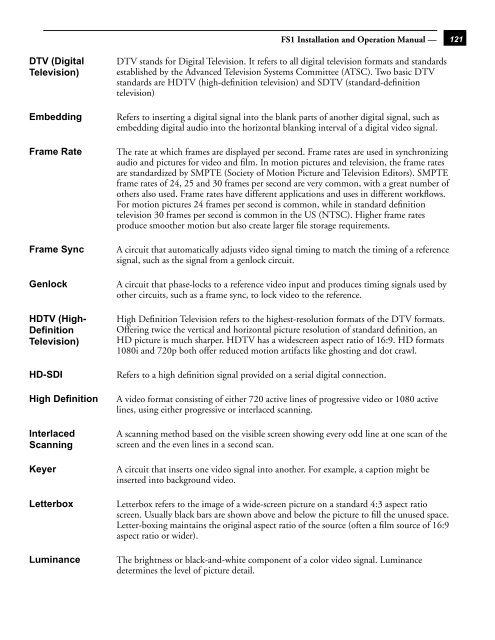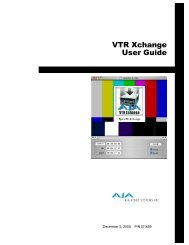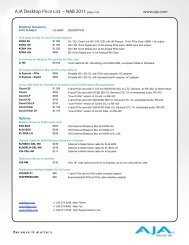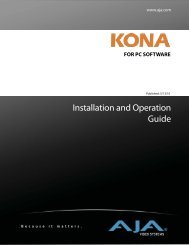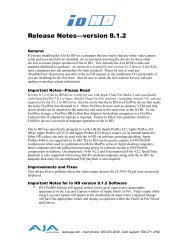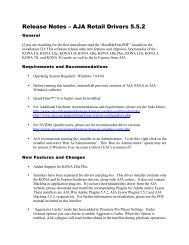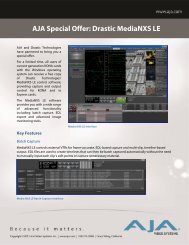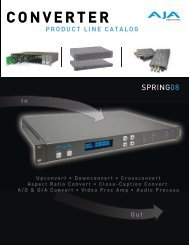AJA FS1 Installation and Operation Guide
AJA FS1 Installation and Operation Guide
AJA FS1 Installation and Operation Guide
You also want an ePaper? Increase the reach of your titles
YUMPU automatically turns print PDFs into web optimized ePapers that Google loves.
DTV (Digital<br />
Television)<br />
<strong>FS1</strong> <strong>Installation</strong> <strong>and</strong> <strong>Operation</strong> Manual —<br />
DTV st<strong>and</strong>s for Digital Television. It refers to all digital television formats <strong>and</strong> st<strong>and</strong>ards<br />
established by the Advanced Television Systems Committee (ATSC). Two basic DTV<br />
st<strong>and</strong>ards are HDTV (high-definition television) <strong>and</strong> SDTV (st<strong>and</strong>ard-definition<br />
television)<br />
Embedding Refers to inserting a digital signal into the blank parts of another digital signal, such as<br />
embedding digital audio into the horizontal blanking interval of a digital video signal.<br />
Frame Rate The rate at which frames are displayed per second. Frame rates are used in synchronizing<br />
audio <strong>and</strong> pictures for video <strong>and</strong> film. In motion pictures <strong>and</strong> television, the frame rates<br />
are st<strong>and</strong>ardized by SMPTE (Society of Motion Picture <strong>and</strong> Television Editors). SMPTE<br />
frame rates of 24, 25 <strong>and</strong> 30 frames per second are very common, with a 1great<br />
number of<br />
others also used. Frame rates have different applications <strong>and</strong> uses in different workflows.<br />
For motion pictures 24 frames per second is common, while in st<strong>and</strong>ard definition<br />
television 30 frames per second is common in the US (NTSC). Higher frame rates<br />
produce smoother motion but also create larger file storage requirements.<br />
Frame Sync A circuit that automatically adjusts video signal timing to match the timing of a reference<br />
signal, such as the signal from a genlock circuit.<br />
Genlock A circuit that phase-locks to a reference video input <strong>and</strong> produces timing signals used by<br />
other circuits, such as a frame sync, to lock video to the reference.<br />
HDTV (High-<br />
Definition<br />
Television)<br />
High Definition Television refers to the highest-resolution formats of the DTV formats.<br />
Offering twice the vertical <strong>and</strong> horizontal picture resolution of st<strong>and</strong>ard definition, an<br />
HD picture is much sharper. HDTV has a widescreen aspect ratio of 16:9. HD formats<br />
1080i <strong>and</strong> 720p both offer reduced motion artifacts like ghosting <strong>and</strong> dot crawl.<br />
HD-SDI Refers to a high definition signal provided on a serial digital connection.<br />
High Definition A video format consisting of either 720 active lines of progressive video or 1080 active<br />
lines, using either progressive or interlaced scanning.<br />
Interlaced<br />
Scanning<br />
A scanning method based on the visible screen showing every odd line at one scan of the<br />
screen <strong>and</strong> the even lines in a second scan.<br />
Keyer A circuit that inserts one video signal into another. For example, a caption might be<br />
inserted into background video.<br />
Letterbox Letterbox refers to the image of a wide-screen picture on a st<strong>and</strong>ard 4:3 aspect ratio<br />
screen. Usually black bars are shown above <strong>and</strong> below the picture to fill the unused space.<br />
Letter-boxing maintains the original aspect ratio of the source (often a film source of 16:9<br />
aspect ratio or wider).<br />
Luminance The brightness or black-<strong>and</strong>-white component of a color video signal. Luminance<br />
determines the level of picture detail.<br />
121


